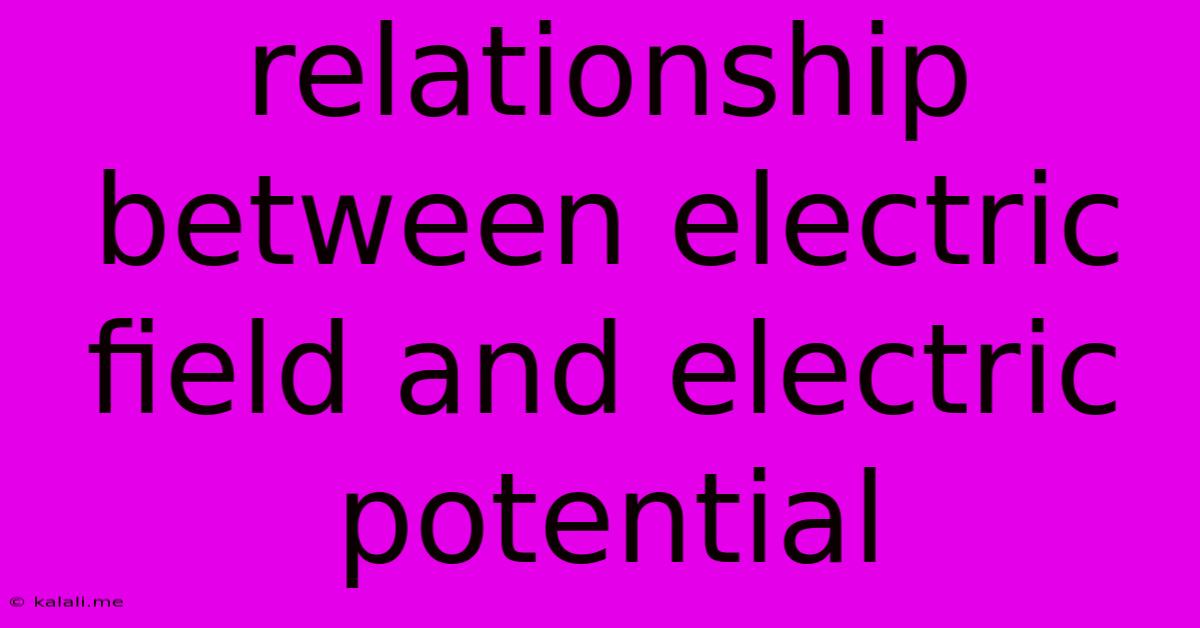Relationship Between Electric Field And Electric Potential
Kalali
May 21, 2025 · 3 min read

Table of Contents
The Intimate Relationship Between Electric Field and Electric Potential
Understanding the relationship between electric field and electric potential is fundamental to grasping the intricacies of electromagnetism. While distinct concepts, they are inextricably linked, providing complementary perspectives on how charges interact and influence their surroundings. This article delves into this crucial connection, exploring their definitions, the mathematical relationship, and practical implications.
Electric potential, often measured in volts, represents the potential energy per unit charge at a specific point in an electric field. Imagine it as the "voltage" at a location – the higher the potential, the greater the potential energy a charge would possess if placed there. Conversely, the electric field describes the force per unit charge experienced by a charge placed at a point. Think of it as the "push" or "pull" exerted on a charge.
Defining Electric Potential
Electric potential (V) at a point is defined as the work done per unit positive charge in bringing a test charge from infinity (where the potential is conventionally set to zero) to that point. This work is done against the electric field. Therefore, a higher potential implies more work is required to bring a charge to that location, indicating a stronger influence of the electric field in that region. Regions of high potential are often associated with regions of high charge density.
Defining Electric Field
The electric field (E) at a point is a vector quantity defined as the force (F) experienced by a unit positive charge (q) placed at that point. Mathematically, E = F/q. The direction of the electric field is the direction of the force on a positive charge. The field lines visually represent the direction and magnitude of the electric field; denser lines indicate a stronger field. Electric field lines always originate from positive charges and terminate on negative charges.
The Mathematical Connection: Gradient
The core relationship between electric field and potential lies in the mathematical concept of the gradient. The electric field is the negative gradient of the electric potential. In simpler terms, the electric field at a point indicates the direction and magnitude of the steepest decrease in potential. This relationship is expressed mathematically as:
E = -∇V
where ∇ (nabla) is the gradient operator. In three dimensions, this expands to:
E = - (∂V/∂x)î - (∂V/∂y)ĵ - (∂V/∂z)k̂
This equation signifies that the electric field is a vector pointing in the direction of the greatest decrease in potential, and its magnitude is proportional to the rate of change of potential. A large change in potential over a short distance results in a strong electric field. Conversely, a gradual change in potential implies a weaker field.
Practical Implications and Applications
This fundamental relationship has numerous applications in various fields:
- Capacitors: The electric field between capacitor plates is directly related to the potential difference (voltage) across them. Understanding this relationship is crucial in designing and characterizing capacitors.
- Electrostatic Potential Energy: The potential energy of a charge in an electric field is directly proportional to both the charge and the potential at its location.
- Circuit Analysis: Circuit analysis relies heavily on understanding potential differences (voltages) and their relationship to the resulting electric fields driving the current flow.
- Particle Accelerators: The electric fields used to accelerate charged particles are carefully controlled by manipulating the potential differences across various regions of the accelerator.
In conclusion, electric field and electric potential are intrinsically linked concepts. While the electric field describes the force acting on a charge, electric potential describes the potential energy per unit charge. Their mathematical relationship, elegantly captured by the gradient, is central to our understanding of electromagnetism and forms the foundation for numerous practical applications. By understanding this interplay, we gain a deeper insight into the behavior of charges and their interactions within electric fields.
Latest Posts
Latest Posts
-
How Do I Turn Off The Hot Water Supply
May 22, 2025
-
How Do I Write One Million
May 22, 2025
-
How To Switch Off Hot Water Supply
May 22, 2025
-
Successful Payment But My Bank Account Hasn T Been Charged
May 22, 2025
-
How Many Years Ago Was The Birth Of Jesus
May 22, 2025
Related Post
Thank you for visiting our website which covers about Relationship Between Electric Field And Electric Potential . We hope the information provided has been useful to you. Feel free to contact us if you have any questions or need further assistance. See you next time and don't miss to bookmark.